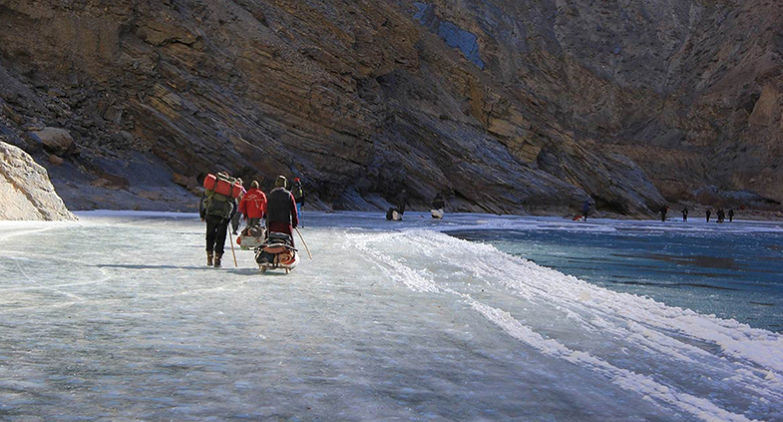Leh and Ladakh, located in the picturesque state of Jammu and Kashmir between the Great Himalayas and the Karakoram mountains, are two of the most breathtaking locations on earth. Each year it attracts countless tourists from all over the world. Leh and Ladakh, which are nothing but paradisiacal beauty, are overflowing with mesmerizing green spaces, sparkling monasteries, and lovely villages. The moment you land, this beautiful alpine hamlet welcomes you with its breathtaking splendour. Breathe in the clear air and treat your eves the serenity of blue sky and let your soul remember how peace feels.
The region’s brightly coloured gompas or monasteries serve as a reminder that Leh, situated at a height of 3505 metres above sea level, is the centre of Tibeto-Buddhist culture. Leh being on the lap of the snow clad Himalayas, provides visitors with the opportunity to both experience the Himalayas’ enchanted allure and explore its untamed, rocky terrains.
Ladakh, famously known for its cold desert, offers the viewer a wealth of unspoiled natural beauty. Travelers will always have an amazing and unforgettable experience when they visit Leh and Ladakh since there are so many tourist destinations to explore. We have curated a list for your convenience:
Table of Contents
Places to Visit in Ladakh
The Leh Palace
The eight-story Leh Palace, which was built in the 16th century and formerly served as the residence of the Ladakh king, is still owned by the Ladakhi royal family. The palace resembles the well-known Potala of Lhasa in China. Unfortunately, its architectural heritage has been harmed by Kashmiri assaults during the previous century. When you arrive, do look out for the little Khar Gompa inside the palace as well as the spectacular palace wall murals that have been scraped and smeared over the years. You may notice the the colourful prayer flags flapping in the wind from the palace roof. If the weather is favourable, you’ll be rewarded with an opportunity to see the snow-covered Zanskar Range, which, despite rising from the opposite side of the Indus River, appears to be very close.
The Shanti Stupa
To honour 2500 years of Buddhism, a Japanese Buddhist organisation constructed Changspa’s Shanti Stupa on a hilltop, a sacred temple with a white dome which promotes world peace. The Shanti Stupa, which His Holiness the Dalai Lama opened in 1985, is home to some beautiful statues of Gautam Buddha as well as sacred artifacts and holy texts.The beauty of the stupa with moonlight shimmering on it’s white dome at night is a sight to behold. Moreover, like a bonus to the already existing breathtaking view, this place provides a stunning sunset view of the Himalayas which you just can’t miss.
The Shey Monastery
The Shey Monastery, which is about 15 kilometres south of Leh, was established by Lhachen Palgyigon, the first king of Ladakh. It served as the capital for many years. It is well-known for the magnificent, 12 m-tall copper statue of Shakyamuni Buddha that was crafted in 1633 and is exquisitely embellished with precious stones. The statue is the second-largest in Ladakh.
Hemis National Park
The Indus River runs along the perimeter of the Hemis National Park which spreads over an area of 4440 sq. km. The park, which is home to approximately 200 snow leopards, Asiatic ibex, and Himalayan griffon vultures, is regarded as the very best example of Ladakh’s wilderness.
The Hall of Fame Museum
The Indian Army built the Hall of Fame museum in honour of the valiant Indian troops who lost their lives protecting the homeland throughout the Indo-Pak conflicts. You’ll find the Hall of Fame Museum about 4 miles outside the city of Leh, on the Leh-Kargil Road. It serves as a poignant reminder of the enormous sacrifices made by our military to protect our nation. Massive Kargil battle artefacts are displayed in one area of the museum. Discover the uniforms, daily tools, and multi-layered shoes of the soldiers put on display in the other section, which is entirely devoted to the Siachen War and its heroes. Find their food on display as well, primarily frozen and packed food that was heated by lighting little Hexamycin tablet balls. It is unquestionably a worthwhile visit.
Among the other notable sites are the Hemis Gompa which is adorned in beautiful paintings and frescoes on its walls and hold several silver and gold stupas, a copper gilt Budhha stupa and the 12m long Thangka painting which is the largest in Ladakh. You may visit the Nubra Valley and the Pangong Lake for their mesmerizing beauty and experience the scenario that looks no less than live paintings. No matter how cold, Leh and Ladakh would always welcome you warmly.

